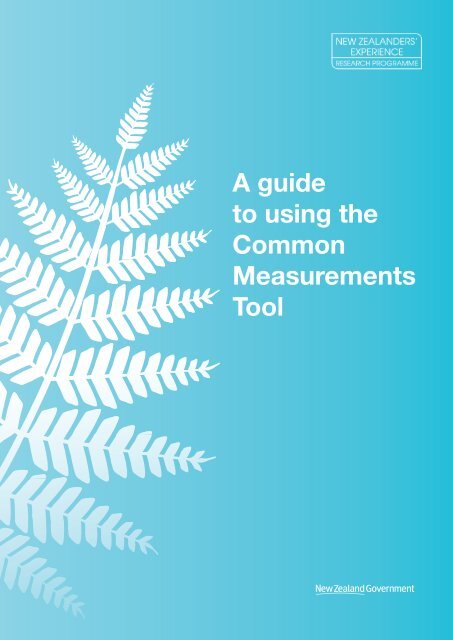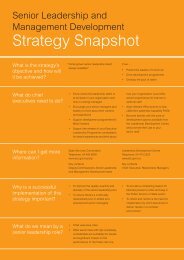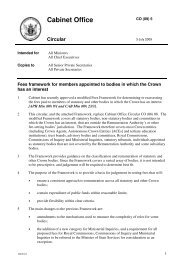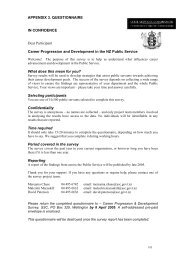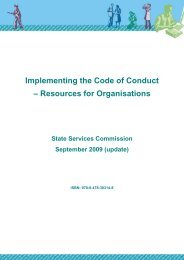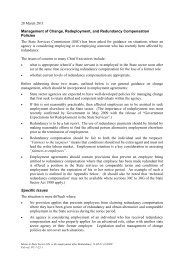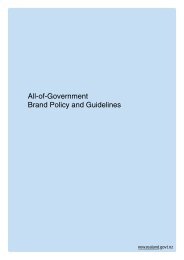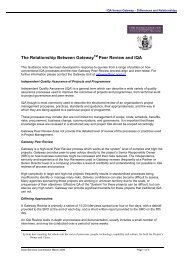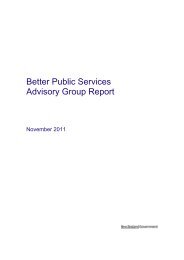A guide to using the Common Measurements Tool - State Services ...
A guide to using the Common Measurements Tool - State Services ...
A guide to using the Common Measurements Tool - State Services ...
You also want an ePaper? Increase the reach of your titles
YUMPU automatically turns print PDFs into web optimized ePapers that Google loves.
A <strong>guide</strong><br />
<strong>to</strong> <strong>using</strong> <strong>the</strong><br />
<strong>Common</strong><br />
<strong>Measurements</strong><br />
<strong>Tool</strong>
This <strong>guide</strong> contains material from <strong>the</strong> <strong>Common</strong> <strong>Measurements</strong> <strong>Tool</strong>, used<br />
under licence and reproduced with <strong>the</strong> permission of <strong>the</strong> Institute for Citizen-<br />
Centred Service.<br />
Published by <strong>the</strong> <strong>State</strong> <strong>Services</strong> Commission<br />
ISBN: 978-0-478-36100-1<br />
March 2010<br />
Copyright / terms of use<br />
All information published in this publication is Crown copyright. The information<br />
is licensed under <strong>the</strong> Creative <strong>Common</strong>s Attribution 3.0 New Zealand licence. The<br />
terms of use under this licence are detailed below.<br />
This work is licensed under <strong>the</strong> Creative <strong>Common</strong>s Attribution-<br />
Noncommercial-No Derivative Works 3.0 New Zealand licence. [In essence, you are free<br />
<strong>to</strong> copy and distribute <strong>the</strong> work (including in o<strong>the</strong>r media and formats) for non-commercial<br />
purposes, as long as you attribute <strong>the</strong> work <strong>to</strong> <strong>the</strong> Crown, do not adapt <strong>the</strong> work and abide<br />
by <strong>the</strong> o<strong>the</strong>r licence terms.] To view a copy of this licence, visit<br />
http://creativecommons.org/licenses/by-nc-nd/3.0/nz/. Attribution <strong>to</strong> <strong>the</strong> Crown should be<br />
in written form and not by reproduction of any such emblem, logo or Coat of Arms.<br />
Note: This document may be updated from time <strong>to</strong> time. Please check <strong>the</strong> website<br />
www.ssc.govt.nz/common-measurements-<strong>to</strong>ol <strong>to</strong> ensure you have <strong>the</strong> current version.
How <strong>to</strong> use this <strong>guide</strong><br />
This <strong>guide</strong> is written for project managers who are responsible for undertaking client<br />
satisfaction surveys <strong>using</strong> <strong>the</strong> <strong>Common</strong> <strong>Measurements</strong> <strong>Tool</strong> (CMT). The <strong>guide</strong> focuses on<br />
specific issues related <strong>to</strong> <strong>using</strong> <strong>the</strong> CMT; it does not explain how <strong>to</strong> build and design surveys.<br />
Previous knowledge and experience with survey research methodology is assumed.<br />
Section 1 provides you with some background on <strong>the</strong> CMT in <strong>the</strong> New Zealand context and<br />
refers <strong>to</strong> <strong>the</strong> Drivers of Satisfaction with Service Quality.<br />
Section 2 is designed <strong>to</strong> help you get started, describing <strong>the</strong> core questions that must be used<br />
and <strong>the</strong> o<strong>the</strong>r types of questions offered and how <strong>to</strong> begin selecting questions for your survey.<br />
Sections 3 provides sample surveys with <strong>the</strong> CMT questions included.<br />
A final section outlines where additional information may be available.<br />
Please note:<br />
The CMT is provided <strong>to</strong> New Zealand under license from Canada. New Zealand <strong>State</strong><br />
<strong>Services</strong> agencies can take up <strong>the</strong> CMT, free of charge, by signing a Memorandum of<br />
Understanding (MoU) with <strong>the</strong> <strong>State</strong> <strong>Services</strong> Commission (SSC). Local authorities and<br />
charitable entities can use <strong>the</strong> CMT, for a fee, by signing a Letter of Agreement (LoA) with <strong>the</strong><br />
SSC. Agencies and organisations must abide by <strong>the</strong> terms of <strong>the</strong> respective MoU or LoA, in<br />
particular:<br />
<br />
<br />
<br />
use <strong>the</strong> New Zealand core questions<br />
use <strong>the</strong> wording of <strong>the</strong> CMT questions as <strong>the</strong>y are written, and<br />
provide a copy of <strong>the</strong>ir data for benchmarking purposes.<br />
For fur<strong>the</strong>r information, please contact <strong>Common</strong><strong>Measurements</strong><strong>Tool</strong>@ssc.govt.nz<br />
Published March 2010
Contents<br />
Section One ............................................................................................................................. 1<br />
Introduction .............................................................................................................................. 1<br />
Understanding <strong>the</strong> Drivers of Satisfaction ........................................................................... 2<br />
Section Two ............................................................................................................................. 4<br />
Components of <strong>the</strong> CMT .......................................................................................................... 4<br />
The Core Questions .............................................................................................................. 4<br />
Telephone Service Delivery specific questions ................................................................... 5<br />
Paired Response Scales ........................................................................................................ 5<br />
Benchmarking internationally .............................................................................................. 6<br />
Selecting o<strong>the</strong>r CMT Questions ........................................................................................... 6<br />
Cus<strong>to</strong>mising <strong>the</strong> CMT .......................................................................................................... 7<br />
Demographic questions ........................................................................................................ 7<br />
Text and spoken versions ..................................................................................................... 7<br />
Benchmarking nationally ..................................................................................................... 8<br />
Section Three .......................................................................................................................... 9<br />
Example A: A Written Survey ................................................................................................. 9<br />
Example B: A Spoken Survey ................................................................................................ 12<br />
Section Four .......................................................................................................................... 14<br />
Help available from <strong>the</strong> SSC .................................................................................................. 14
The <strong>Common</strong> <strong>Measurements</strong> <strong>Tool</strong> March 2010 <strong>State</strong> <strong>Services</strong> Commission<br />
Section One<br />
Introduction<br />
The New Zealanders’ Experience research programme explores what New Zealanders think of<br />
<strong>the</strong>ir <strong>State</strong> <strong>Services</strong>. 1 To improve New Zealanders’ experience of <strong>State</strong> <strong>Services</strong> requires <strong>State</strong><br />
servants <strong>to</strong> look at <strong>the</strong> services <strong>the</strong>y are providing from <strong>the</strong> viewpoint of <strong>the</strong> service user – <strong>the</strong><br />
‘outside-in’ perspective. Asking New Zealanders for <strong>the</strong>ir views about <strong>the</strong> quality of<br />
government services <strong>the</strong>y receive is one of <strong>the</strong> best ways of building an understanding of this.<br />
The research programme provides evidence for making improvements <strong>to</strong> services that will<br />
have <strong>the</strong> greatest impact on satisfaction.<br />
The research programme draws on international best practice in public service satisfaction<br />
surveys. Canada has been identified as a world leader in citizen-centred public sec<strong>to</strong>r service<br />
delivery. Part of its success is due <strong>to</strong> <strong>the</strong> use of two <strong>to</strong>ols:<br />
<br />
<br />
Citizens First, a national survey of Canadians that measures satisfaction with service<br />
delivery and identifies opportunities for improvements, and<br />
The <strong>Common</strong> <strong>Measurements</strong> <strong>Tool</strong> (CMT). The CMT is a set of survey questions and<br />
scales that allows individual agencies <strong>to</strong> survey <strong>the</strong>ir own clients’ satisfaction and<br />
identify service delivery improvements for service users.<br />
In 2007, <strong>the</strong> <strong>State</strong> <strong>Services</strong> Commission (SSC) purchased <strong>the</strong> licences for both Citizens First<br />
and <strong>the</strong> CMT and adapted <strong>the</strong>m for use across <strong>the</strong> New Zealand <strong>State</strong> <strong>Services</strong>. Citizens First<br />
was adapted for <strong>the</strong> Kiwis Count public survey.<br />
The key part of <strong>the</strong> CMT is <strong>the</strong> eight core questions. These questions are based on <strong>the</strong> Drivers<br />
Survey which investigated what drives New Zealanders’ satisfaction with <strong>the</strong> quality of service<br />
<strong>the</strong>y receive from public service organisations 2 . There are seven extra questions that match <strong>the</strong><br />
Canadian core questions.<br />
The CMT question bank also includes over 100 additional questions that can be used <strong>to</strong> survey<br />
different service delivery channels and types of service. The CMT is designed <strong>to</strong> be flexible<br />
enough <strong>to</strong> be used alone or in components <strong>to</strong> support your existing client satisfaction<br />
methodologies and measures.<br />
By <strong>using</strong> <strong>the</strong> questions set out in <strong>the</strong> CMT, agencies can compare <strong>the</strong>ir performance with o<strong>the</strong>r<br />
New Zealand <strong>State</strong> <strong>Services</strong> agencies as well as benchmark internationally with Canada and<br />
o<strong>the</strong>r jurisdictions that adopt it.<br />
1 www.ssc.govt.nz/nzers-experience<br />
2 The term ‘public service’ was used in <strong>the</strong> survey as previous research indicated this is <strong>the</strong> term most commonly used by New<br />
Zealanders when describing <strong>State</strong> <strong>Services</strong>. For a copy of <strong>the</strong> research see <strong>the</strong> 2007 Drivers Survey, www.ssc.govt.nz/driversreport<br />
1
The <strong>Common</strong> <strong>Measurements</strong> <strong>Tool</strong> March 2010 <strong>State</strong> <strong>Services</strong> Commission<br />
The real value of <strong>the</strong> CMT lies in agencies taking action on <strong>the</strong> results <strong>to</strong> improve services.<br />
The CMT is a <strong>to</strong>ol <strong>to</strong> help you achieve something; it is not an end in itself. Understanding<br />
what your clients’ particular drivers are, which driver performed best, which was worst, and<br />
which priority for improvement is most important from your clients’ perspective, are all issues<br />
that you will want <strong>to</strong> consider.<br />
Particular attention should be paid <strong>to</strong> <strong>the</strong> drivers of satisfaction when setting improvement<br />
priorities. Comprehensive information based on <strong>the</strong>se provides a solid foundation on which <strong>to</strong><br />
base decision making, such as <strong>the</strong> areas <strong>to</strong> focus improvement efforts and resource allocation.<br />
It is also likely <strong>to</strong> secure for your agency <strong>the</strong> biggest gains in client satisfaction.<br />
Understanding <strong>the</strong> Drivers of Satisfaction<br />
The CMT is made up of eight core questions that measure <strong>the</strong> key drivers of client<br />
satisfaction. The Drivers Survey identified a set of six drivers that have <strong>the</strong> greatest impact on<br />
New Zealanders’ overall satisfaction with <strong>the</strong> quality of service delivery. These are:<br />
<br />
<br />
<br />
<br />
<br />
<br />
The service experience met your expectations<br />
Staff were competent<br />
Staff kept <strong>the</strong>ir promises – that is, <strong>the</strong>y did what <strong>the</strong>y said <strong>the</strong>y would do<br />
You were treated fairly<br />
You feel your individual circumstances were taken in<strong>to</strong> account<br />
It’s an example of good value for tax dollars spent.<br />
This set of six drivers accounts for just over two-thirds (69%) of New Zealanders’ satisfaction<br />
with service quality. The survey found that New Zealanders assigned different levels of<br />
importance <strong>to</strong> <strong>the</strong> different drivers, with ‘<strong>the</strong> service met your expectations’ being <strong>the</strong> most<br />
important, as shown in <strong>the</strong> following chart.<br />
Figure 1<br />
Drivers of Satisfaction with Service Quality<br />
50%<br />
40%<br />
30%<br />
20%<br />
10%<br />
31%<br />
19%<br />
14% 13% 13%<br />
11%<br />
0%<br />
The service<br />
experience met<br />
your<br />
expectations<br />
Staff were<br />
competent<br />
Staff kept <strong>the</strong>ir<br />
promises<br />
You w ere<br />
treated fairly<br />
You feel your<br />
individual<br />
circumstances<br />
w ere taken in<strong>to</strong><br />
account<br />
It's an example of<br />
good value for<br />
tax dollars spent<br />
2
The <strong>Common</strong> <strong>Measurements</strong> <strong>Tool</strong> March 2010 <strong>State</strong> <strong>Services</strong> Commission<br />
Drivers of satisfaction with telephone service delivery<br />
The drivers of satisfaction with service quality do vary depending on <strong>the</strong> channel through<br />
which those services are delivered.<br />
Kiwis Count 2007 asked New Zealanders how <strong>the</strong>y had contacted <strong>the</strong> public service <strong>the</strong>y had<br />
used most recently and <strong>the</strong>ir level of satisfaction with <strong>the</strong> method of contact <strong>the</strong>y had used.<br />
Calling on <strong>the</strong> phone was <strong>the</strong> second most common method but had <strong>the</strong> lowest satisfaction<br />
rating. Given its widespread use and comparably lower levels of satisfaction, fur<strong>the</strong>r analysis<br />
was carried out <strong>to</strong> identify <strong>the</strong> drivers of satisfaction with telephone service delivery. This<br />
identified that <strong>the</strong>re were five drivers that have <strong>the</strong> greatest impact on satisfaction. Toge<strong>the</strong>r<br />
<strong>the</strong>se five drivers account for 79% of satisfaction amongst those who used <strong>the</strong> telephone on<br />
<strong>the</strong>ir most recent experience. They are:<br />
<br />
<br />
<br />
<br />
<br />
Overall, you have confidence that <strong>the</strong>ir staff do a good job<br />
The service experience met your expectations<br />
You got accurate information<br />
The amount of time it <strong>to</strong>ok <strong>to</strong> get <strong>the</strong> overall service was reasonable<br />
I got what I needed <strong>using</strong> <strong>the</strong> telephone<br />
The following chart represents <strong>the</strong>ir relative importance.<br />
Figure 2<br />
50%<br />
40%<br />
30%<br />
30% 29%<br />
20%<br />
10%<br />
18%<br />
14%<br />
10%<br />
0%<br />
Overall, you have<br />
confidence that <strong>the</strong>ir<br />
staff do a good job<br />
The service<br />
experience met your<br />
expectations<br />
You got accurate<br />
information<br />
The amount of time it<br />
<strong>to</strong>ok <strong>to</strong> get <strong>the</strong> overall<br />
servce w as<br />
reasonable<br />
I got w hat I needed<br />
<strong>using</strong> <strong>the</strong> telephone<br />
To help you <strong>to</strong> understand what <strong>the</strong> drivers mean <strong>to</strong> New Zealanders, <strong>the</strong> SSC has published a<br />
report that looks at what each of <strong>the</strong> specific drivers mean and what can be done <strong>to</strong> improve<br />
satisfaction for that driver. The report is available on <strong>the</strong> SSC website at<br />
www.ssc.govt.nz/understanding-drivers-report.<br />
Understanding how your agency’s services are performing against <strong>the</strong> drivers of satisfaction<br />
will assist you in identifying your clients’ priorities for improvement in those services.<br />
The next section contains <strong>the</strong> core questions <strong>to</strong> be used in your survey.<br />
3
The <strong>Common</strong> <strong>Measurements</strong> <strong>Tool</strong> March 2010 <strong>State</strong> <strong>Services</strong> Commission<br />
Section Two<br />
Components of <strong>the</strong> CMT<br />
The Core Questions<br />
The eight core questions aim <strong>to</strong> measure <strong>the</strong> key drivers of service quality satisfaction. Each<br />
driver of satisfaction is reflected in at least one of <strong>the</strong> core questions. The core questions create<br />
consistency and enable direct and comparative measurement of client satisfaction across<br />
agencies.<br />
Since <strong>the</strong> core questions are directly related <strong>to</strong> <strong>the</strong> drivers of satisfaction, <strong>the</strong> entire question set<br />
must be used in your survey. The questions and rating scales cannot be modified as <strong>the</strong>y must<br />
be consistent for benchmarking with o<strong>the</strong>r agencies. That is, <strong>the</strong> actual wording and scale must<br />
be identical.<br />
However, it is not necessary <strong>to</strong> use <strong>the</strong> questions in <strong>the</strong> same order, or with <strong>the</strong> same headings.<br />
Figure 3<br />
The Core Questions<br />
Drivers Questions/<strong>State</strong>ments Satisfaction<br />
Very<br />
Very<br />
dissatisfied satisfied<br />
SATISFACTION<br />
1 Overall Satisfaction* How satisfied were you with <strong>the</strong> overall quality 1 2 3 4 5<br />
of service delivery?<br />
EXPECTATIONS<br />
2 Expectations Before going <strong>to</strong> [agency] for this service, what Very poor Very good<br />
quality of service did you expect?<br />
service<br />
service<br />
1 2 3 4 5<br />
3 Met Expectations Looking back, how did <strong>the</strong> service you got Much worse Much better<br />
from [agency] compare <strong>to</strong> what you expected? than I<br />
than I<br />
expected expected<br />
1 2 3 4 5<br />
PERFORMANCE<br />
Driver Questions/<strong>State</strong>ments Agreement<br />
Strongly<br />
Strongly<br />
disagree<br />
agree<br />
4 Competence* Staff were competent 1 2 3 4 5 NA<br />
5 Promises Staff did what <strong>the</strong>y said <strong>the</strong>y would do 1 2 3 4 5 NA<br />
6 Fairness* I was treated fairly 1 2 3 4 5 NA<br />
7 Individual<br />
I feel my individual circumstances were taken<br />
Circumstances in<strong>to</strong> account<br />
8 Good value It’s an example of good value for tax dollars<br />
spent<br />
1 2 3 4 5 NA<br />
1 2 3 4 5 NA<br />
* These questions are also related <strong>to</strong> <strong>the</strong> Canadian core questions.<br />
4
The <strong>Common</strong> <strong>Measurements</strong> <strong>Tool</strong> March 2010 <strong>State</strong> <strong>Services</strong> Commission<br />
Telephone Service Delivery specific questions<br />
The following statements can be used <strong>to</strong> measure your clients’ satisfaction specifically with<br />
your telephone service delivery. These statements, based on <strong>the</strong> drivers of satisfaction, have<br />
been derived from <strong>the</strong> CMT Question Bank or from questions previously used. As yet, <strong>the</strong>se<br />
statements have not been subjected <strong>to</strong> <strong>the</strong> rigorous, multi-testing process in New Zealand that<br />
<strong>the</strong> core questions went through. We suggest you pre-test <strong>the</strong>m and invite you <strong>to</strong> share your<br />
results with us.<br />
Figure 4<br />
Drivers Questions/<strong>State</strong>ments Agreement<br />
Strongly<br />
Strongly<br />
disagree<br />
agree<br />
Confidence<br />
Overall, you have confidence that staff do a 1 2 3 4 5 NA<br />
good job<br />
Information I received accurate information 1 2 3 4 5 NA<br />
Waiting time<br />
The amount of time it <strong>to</strong>ok <strong>to</strong> get <strong>the</strong> overall 1 2 3 4 5 NA<br />
service was acceptable<br />
Outcome I got what I needed <strong>using</strong> <strong>the</strong> telephone 1 2 3 4 5 NA<br />
Paired Response Scales<br />
Figure 5 presents some drivers with a two paired response scale, one measuring how well <strong>the</strong><br />
service was delivered (performance) and <strong>the</strong> o<strong>the</strong>r measuring how important that aspect of <strong>the</strong><br />
service is <strong>to</strong> your client. This allows you <strong>to</strong> identify <strong>the</strong> elements of your service delivery<br />
process that will lead <strong>to</strong> <strong>the</strong> greatest improvements in client satisfaction. Foc<strong>using</strong> on <strong>the</strong> key<br />
things in service delivery that are important <strong>to</strong> your clients will produce <strong>the</strong> biggest return in<br />
terms of client satisfaction.<br />
Figure 5<br />
Driver Questions/<strong>State</strong>ments Agreement Importance<br />
Strongly Strongly Not at all Very<br />
disagree agree important important<br />
Competence Staff were competent 1 2 3 4 5 NA 1 2 3 4 5 NA<br />
Promises Staff did what <strong>the</strong>y said <strong>the</strong>y 1 2 3 4 5 NA 1 2 3 4 5 NA<br />
would do<br />
Fairness I was treated fairly 1 2 3 4 5 NA 1 2 3 4 5 NA<br />
Individual<br />
Circumstances<br />
Good value<br />
I feel my individual<br />
circumstances were taken in<strong>to</strong><br />
account<br />
It’s an example of good value for<br />
tax dollars spent<br />
1 2 3 4 5 NA 1 2 3 4 5 NA<br />
1 2 3 4 5 NA 1 2 3 4 5 NA<br />
Using <strong>the</strong> paired scales allows you <strong>to</strong> assess <strong>the</strong> relationship between importance and<br />
performance and decide where you may wish <strong>to</strong> direct your improvement efforts.<br />
5
The <strong>Common</strong> <strong>Measurements</strong> <strong>Tool</strong> March 2010 <strong>State</strong> <strong>Services</strong> Commission<br />
Benchmarking internationally<br />
The Institute for Citizen-Centred Service (ICCS) in Canada provides a benchmarking service<br />
for all those signed up <strong>to</strong> use <strong>the</strong> CMT. If you wish <strong>to</strong> benchmark internationally, <strong>the</strong> SSC can<br />
forward your results on <strong>to</strong> <strong>the</strong> ICCS, who will provide you (for a fee) with a cus<strong>to</strong>mised<br />
benchmarking report so you can compare your results with comparable overseas organisations.<br />
The process is confidential – each participating organisation is identified <strong>to</strong> o<strong>the</strong>rs only by <strong>the</strong><br />
type of service that it provides such as taxation, law enforcement, etc. Visit <strong>the</strong> ICCS website,<br />
www.iccs-isac.org for current information, including costs.<br />
If your agency is interested in benchmarking internationally, you will need <strong>to</strong> include some or<br />
all of <strong>the</strong> following seven questions that make up <strong>the</strong> rest of <strong>the</strong> Canadian core questions 3 , in<br />
addition <strong>to</strong> <strong>the</strong> eight New Zealand core questions.<br />
Figure 6<br />
The Canadian Core Questions<br />
Canadian Drivers Questions/<strong>State</strong>ments Satisfaction<br />
Very<br />
SATISFACTION<br />
1 Timeliness Overall, how satisfied were you with <strong>the</strong><br />
amount of time it <strong>to</strong>ok <strong>to</strong> get <strong>the</strong> service?<br />
2 Accessibility Overall, how satisfied were you with <strong>the</strong><br />
dissatisfied<br />
Very<br />
satisfied<br />
1 2 3 4 5<br />
1 2 3 4 5<br />
accessibility of <strong>the</strong> service/product?<br />
PERFORMANCE<br />
Driver Questions/<strong>State</strong>ments Agreement<br />
Strongly<br />
Strongly<br />
disagree<br />
agree<br />
3 Information I was informed of everything I had <strong>to</strong> do <strong>to</strong> get 1 2 3 4 5 NA<br />
<strong>the</strong> service/product<br />
4 Extra mile Staff went <strong>the</strong> extra mile <strong>to</strong> make sure I got 1 2 3 4 5 NA<br />
what I needed<br />
5 Access I was able <strong>to</strong> get through <strong>to</strong> a staff member 1 2 3 4 5 NA<br />
without difficulty<br />
6 Waiting time I waited an acceptable amount of time at <strong>the</strong> 1 2 3 4 5 NA<br />
service location<br />
OUTCOME<br />
Drivers Questions/<strong>State</strong>ments Satisfaction<br />
7 Outcome In <strong>the</strong> end did you get what you<br />
needed?<br />
Yes No I got part of what I needed<br />
Selecting o<strong>the</strong>r CMT Questions<br />
Measurement and surveying are not limited <strong>to</strong> <strong>the</strong> eight New Zealand core questions, or <strong>the</strong><br />
seven Canadian questions above. Agencies can also use any of <strong>the</strong> additional CMT questions.<br />
However, only those organisations who have signed ei<strong>the</strong>r a MoU or LoA with <strong>the</strong> SSC can<br />
access <strong>the</strong> CMT Question Bank. Before including additional CMT questions in your survey,<br />
we encourage you <strong>to</strong> discuss this with <strong>the</strong> SSC as <strong>the</strong> questions are being progressively tested<br />
for <strong>the</strong> New Zealand context. We also advise you <strong>to</strong> always pre-test <strong>the</strong>m with your staff<br />
and/or clients.<br />
3 The questions differ slightly across service delivery channels so you would use only those questions appropriate <strong>to</strong> <strong>the</strong><br />
relevant service delivery channel.<br />
6
The <strong>Common</strong> <strong>Measurements</strong> <strong>Tool</strong> March 2010 <strong>State</strong> <strong>Services</strong> Commission<br />
Cus<strong>to</strong>mising <strong>the</strong> CMT<br />
The CMT is designed <strong>to</strong> be flexible, so you can create a new survey <strong>using</strong> <strong>the</strong> CMT questions<br />
or add <strong>the</strong>m <strong>to</strong> an existing survey. This also allows you <strong>to</strong> measure satisfaction with those<br />
aspects of services specific <strong>to</strong> your organisation.<br />
Demographic questions<br />
We suggest that if you are including age, ethnicity and gender demographics that you use <strong>the</strong><br />
same categories as in <strong>the</strong> examples provided in section three. This allows for ano<strong>the</strong>r level of<br />
benchmarking.<br />
Text and spoken versions<br />
The CMT question bank contains two parallel versions of <strong>the</strong> CMT, one for administration via<br />
Internet or paper, and an oral version for telephone and in-person administration. Instructions<br />
and introductions require slightly different phrasing in <strong>the</strong> different formats; however <strong>the</strong><br />
questions <strong>the</strong>mselves are identical or nearly so.<br />
Section three of this <strong>guide</strong> provides examples for both versions, <strong>using</strong> <strong>the</strong> core questions.<br />
7
The <strong>Common</strong> <strong>Measurements</strong> <strong>Tool</strong> March 2010 <strong>State</strong> <strong>Services</strong> Commission<br />
Benchmarking nationally<br />
In order <strong>to</strong> facilitate <strong>the</strong> sharing of CMT data across New Zealand agencies, <strong>the</strong> SSC has<br />
established a CMT benchmarking service. Benchmarking data is collected and shared in a way<br />
that ensures <strong>the</strong> anonymity of participating agencies’ results while still allowing comparison<br />
with peer organisations. Agencies are required <strong>to</strong> supply a copy of <strong>the</strong>ir raw data file.<br />
For enquires, please contact CMTBenchmarking@ssc.govt.nz<br />
The objective of benchmarking is <strong>to</strong> enable agencies <strong>to</strong> compare <strong>the</strong>ir results against o<strong>the</strong>r<br />
organisations and <strong>the</strong>n encourage <strong>the</strong>m <strong>to</strong> share <strong>the</strong>ir results. The SSC supports Communities<br />
of Practices, bringing agencies <strong>to</strong>ge<strong>the</strong>r <strong>to</strong> promote <strong>the</strong> sharing of knowledge and experiences.<br />
As part of this, <strong>the</strong> SSC encourages research managers <strong>to</strong> work closely with <strong>the</strong>ir colleagues<br />
responsible for service delivery design and improvement, <strong>to</strong> act on <strong>the</strong> results of this ‘outsidein’<br />
research.<br />
8
The <strong>Common</strong> <strong>Measurements</strong> <strong>Tool</strong> March 2010 <strong>State</strong> <strong>Services</strong> Commission<br />
Section Three<br />
Example A: A Written Survey<br />
An Internet or Paper Survey<br />
The following example shows how <strong>the</strong> CMT questions might be incorporated in<strong>to</strong> your survey.<br />
Any actual survey will be different, as it will reflect <strong>the</strong> objectives and context of a particular<br />
organisation. It may also include non-CMT questions that address your organisation’s specific<br />
services and information needs, or which replicate questions that were used in previous<br />
surveys. Your questionnaire will also include <strong>the</strong> name of your organisation and services where<br />
appropriate.<br />
After a brief introduc<strong>to</strong>ry page stating <strong>the</strong> purpose of <strong>the</strong> survey and stressing confidentiality, <strong>the</strong><br />
questions begin. The shaded boxes illustrate how <strong>the</strong> survey might be divided in<strong>to</strong> six or more<br />
browser pages.<br />
1 Tick each of <strong>the</strong> services/products that you received from [agency] in <strong>the</strong> past year.<br />
- 1. Name of service<br />
- 2. Name of service<br />
- 3. Name of service<br />
- 4. Name of service<br />
- 5. Name of service<br />
2 Which service/product did you receive most recently? Type its number here:<br />
Service number ___________<br />
Please answer <strong>the</strong> remaining questions in <strong>the</strong> survey with regard <strong>to</strong> this service – <strong>the</strong> most<br />
recent service you received from [agency].<br />
3 When did you last use this service?<br />
- Within <strong>the</strong> past week<br />
- Within <strong>the</strong> past month<br />
- Within <strong>the</strong> past 3 months<br />
- Within <strong>the</strong> past year<br />
9
The <strong>Common</strong> <strong>Measurements</strong> <strong>Tool</strong> March 2010 <strong>State</strong> <strong>Services</strong> Commission<br />
4 Circle a number <strong>to</strong> show:<br />
<br />
<br />
how much you agree with <strong>the</strong> statement, and <strong>the</strong>n,<br />
how important this aspect of service was.<br />
If you dealt with more than one staff member, please give a rating overall.<br />
AGREEMENT<br />
IMPORTANCE<br />
STATEMENT Strongly Strongly Not at all Very<br />
disagree agree important important<br />
a. Staff were competent 1 2 3 4 5 NA 1 2 3 4 5 NA<br />
b. Staff did what <strong>the</strong>y said<br />
<strong>the</strong>y would do 1 2 3 4 5 NA 1 2 3 4 5 NA<br />
c. I was treated fairly 1 2 3 4 5 NA 1 2 3 4 5 NA<br />
d. I feel my individual<br />
circumstances were taken<br />
in<strong>to</strong> account 1 2 3 4 5 NA 1 2 3 4 5 NA<br />
e. It’s an example of good 1 2 3 4 5 NA 1 2 3 4 5 NA<br />
value for tax dollars spent<br />
5 Before going <strong>to</strong> [agency] for this service, what quality of service did you expect?<br />
Very poor service<br />
Very good service<br />
1 2 3 4 5<br />
6 Looking back, how did <strong>the</strong> service you got from [agency] compare <strong>to</strong> what you expected?<br />
Much worse than I expected<br />
Much better than I expected<br />
1 2 3 4 5<br />
7 How satisfied were you with <strong>the</strong> overall quality of service delivery?<br />
Very dissatisfied<br />
1 2 3 4 5<br />
Very satisfied<br />
What are <strong>the</strong> <strong>to</strong>p three things [agency] can do <strong>to</strong> improve its service delivery?<br />
1.<br />
2.<br />
3.<br />
10
The <strong>Common</strong> <strong>Measurements</strong> <strong>Tool</strong> March 2010 <strong>State</strong> <strong>Services</strong> Commission<br />
ABOUT YOU<br />
8 Gender<br />
_______ Female<br />
_______ Male<br />
9 Age<br />
_______ under 20 years<br />
_______ 20-24 years<br />
_______ 25-29 years<br />
_______ 30-34 years<br />
_______ 35-39 years<br />
_______ 40-44 years<br />
_______ 45-49 years<br />
_______ 50-54 years<br />
_______ 55-59 years<br />
_______ 60-64 years<br />
_______ 65+<br />
10 Which ethnic group do you belong <strong>to</strong>? Mark <strong>the</strong> space or spaces which apply <strong>to</strong> you<br />
_______ New Zealand European<br />
_______ Māori<br />
_______ Samoan<br />
_______ Cook Island Māori<br />
_______ Tongan<br />
_______ Niuean<br />
_______ Chinese<br />
_______ Indian<br />
_______ o<strong>the</strong>r, please state ____________________<br />
11 Add any o<strong>the</strong>r demographic questions you may wish <strong>to</strong> collect<br />
Your feedback helps us <strong>to</strong> improve our service.<br />
Thank you for participating!<br />
11
The <strong>Common</strong> <strong>Measurements</strong> <strong>Tool</strong> March 2010 <strong>State</strong> <strong>Services</strong> Commission<br />
Example B: A Spoken Survey<br />
A Telephone Survey<br />
After a brief introduction stating <strong>the</strong> purpose of <strong>the</strong> survey and stressing confidentiality, <strong>the</strong><br />
questions begin.<br />
1 Which of <strong>the</strong> following services/products have you received from [agency] in <strong>the</strong> past<br />
year?<br />
___________ 1. Name of service<br />
___________ 2. Name of service<br />
___________ 3. Name of service<br />
___________ 4. Name of service<br />
___________ 5. Name of service<br />
2 Which service/product did you receive most recently?<br />
___________ 1. Name of service<br />
3 When did you last use this service?<br />
___________ Within <strong>the</strong> past week<br />
___________ Within <strong>the</strong> past month<br />
___________ Within <strong>the</strong> past 3 months<br />
___________ Within <strong>the</strong> past year<br />
Thinking about <strong>the</strong> most recent service you received from [agency], I would like <strong>to</strong> read some<br />
statements about <strong>the</strong> delivery of this service/product.<br />
<br />
Please tell me <strong>the</strong> extent <strong>to</strong> which you agree with each statement, where 1 means<br />
“Strongly disagree” and 5 means “Strongly agree”, if you dealt with more than one staff<br />
member, please give a rating overall.<br />
STATEMENT<br />
A<br />
Staff were competent<br />
AGREEMENT<br />
Strongly Strongly<br />
disagree<br />
agree<br />
1 2 3 4 5 NA<br />
IMPORTANCE<br />
Not at all<br />
Very<br />
important important<br />
1 2 3 4 5 NA<br />
B<br />
Staff did what <strong>the</strong>y said <strong>the</strong>y would do<br />
1 2 3 4 5 NA<br />
1 2 3 4 5 NA<br />
C<br />
I was treated fairly<br />
1 2 3 4 5 NA<br />
1 2 3 4 5 NA<br />
D I feel my individual circumstances were taken<br />
in<strong>to</strong> account<br />
E It’s an example of good value for tax dollars<br />
spent<br />
1 2 3 4 5 NA<br />
1 2 3 4 5 NA<br />
1 2 3 4 5 NA<br />
1 2 3 4 5 NA<br />
<br />
Now, tell me how important <strong>the</strong>se aspects of service delivery were <strong>to</strong> you at <strong>the</strong> time,<br />
where 1 means “Not at all important” and 5 means “Very important”.<br />
12
The <strong>Common</strong> <strong>Measurements</strong> <strong>Tool</strong> March 2010 <strong>State</strong> <strong>Services</strong> Commission<br />
4 Before going <strong>to</strong> [agency] for this service, what quality of service did you expect? Use a<br />
scale where 1 means “Very poor service” and 5 means “Very good service”.<br />
Very poor service<br />
Very good service<br />
1 2 3 4 5<br />
5 Looking back, how did <strong>the</strong> service you got from [agency] compare <strong>to</strong> what you<br />
expected? Use a scale where 1 means “Much worse than I expected” and 5 means<br />
“Much better than I expected”.<br />
Much worse than I expected<br />
Much better than I expected<br />
1 2 3 4 5<br />
6 How satisfied were you with <strong>the</strong> overall quality of service delivery? Use a scale where 1<br />
means “Very dissatisfied” and 5 means “Very satisfied”.<br />
Very dissatisfied<br />
Very satisfied<br />
1 2 3 4 5<br />
7 Would you like <strong>to</strong> make any additional comments or suggestions about this service?<br />
Relevant demographic questions (gender, age, ethnicity, etc) <strong>to</strong> complete <strong>the</strong> survey.<br />
End by thanking respondent for participating.<br />
13
The <strong>Common</strong> <strong>Measurements</strong> <strong>Tool</strong> March 2010 <strong>State</strong> <strong>Services</strong> Commission<br />
Section Four<br />
Help available from <strong>the</strong> SSC<br />
The SSC plays a central role in supporting <strong>the</strong> CMT and making it available <strong>to</strong> <strong>State</strong> <strong>Services</strong><br />
organisations. It is able <strong>to</strong> provide assistance on how <strong>to</strong> incorporate <strong>the</strong> CMT in<strong>to</strong> your current<br />
surveys.<br />
Please note, you will be required <strong>to</strong> send your questionnaires <strong>to</strong> <strong>the</strong> SSC before <strong>using</strong> <strong>the</strong>m so<br />
that SSC can ensure consistency in <strong>the</strong> use of <strong>the</strong> CMT questions, for benchmarking purposes.<br />
The SSC is also interested in knowing how <strong>the</strong> CMT is working for users in <strong>the</strong> New Zealand<br />
context, so please stay in <strong>to</strong>uch with <strong>the</strong> CMT project team in order <strong>to</strong> share your learnings.<br />
Contact, <strong>Common</strong><strong>Measurements</strong><strong>Tool</strong>@ssc.govt.nz.<br />
For fur<strong>the</strong>r information, <strong>the</strong> ICCS has made several complementary publications available<br />
through its website, www.iccs-isac.org. These include:<br />
How-<strong>to</strong> Guide <strong>to</strong> Service Improvement Initiatives. Any client survey should be part of a larger<br />
service improvement strategy. A client survey should be developed based on <strong>the</strong> objectives of<br />
that strategy and <strong>the</strong> service improvement goals <strong>the</strong> organization is trying <strong>to</strong> achieve.<br />
Originally published by <strong>the</strong> Canadian Federal Government, this how-<strong>to</strong> <strong>guide</strong> takes a step-bystep<br />
approach <strong>to</strong> planning, implementing, and assessing a service improvement initiative, and<br />
includes specific reference <strong>to</strong> <strong>the</strong> <strong>Common</strong> <strong>Measurements</strong> <strong>Tool</strong>.<br />
How <strong>to</strong> Conduct Cus<strong>to</strong>mer Surveys. The survey questionnaire is only one small part of <strong>the</strong><br />
survey research process. Published in co-operation with <strong>the</strong> Government of Ontario and <strong>the</strong><br />
Government of Quebec, this how-<strong>to</strong> <strong>guide</strong> details <strong>the</strong> survey research process from defining<br />
objectives <strong>to</strong> determining sample sizes <strong>to</strong> interpreting data. It also includes specific reference <strong>to</strong><br />
<strong>the</strong> <strong>Common</strong> <strong>Measurements</strong> <strong>Tool</strong>.<br />
CMT User Manual. This manual is focused specifically on challenges associated with <strong>using</strong><br />
<strong>the</strong> <strong>Common</strong> <strong>Measurements</strong> <strong>Tool</strong>.<br />
In addition, Statistics New Zealand has produced a <strong>guide</strong> aimed at those who undertake or<br />
commission surveys, called A Guide <strong>to</strong> Good Survey Design 4 .<br />
4 http://www.stats.govt.nz/methods_and_services/<strong>guide</strong>-and-tu<strong>to</strong>rials/user-<strong>guide</strong>s/<strong>guide</strong>-<strong>to</strong>-good-survey-design-2ndedition.aspx<br />
14
<strong>State</strong> <strong>Services</strong> Commission<br />
100 Molesworth Street<br />
PO Box 329<br />
Welling<strong>to</strong>n<br />
New Zealand<br />
Phone: +64 4 495 6600<br />
Fax: +64 4 495 6686<br />
www.ssc.govt.nz<br />
March 2010


